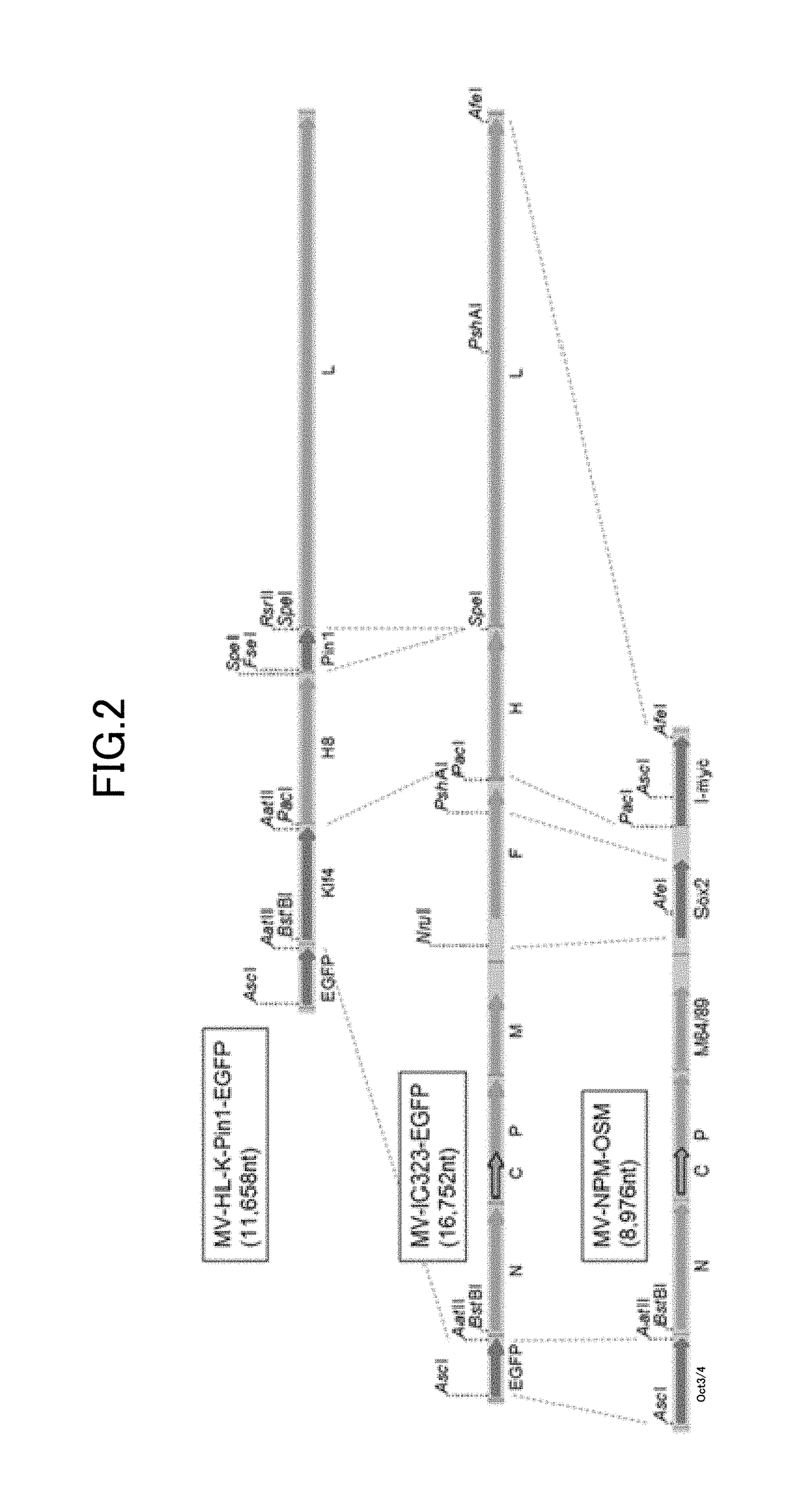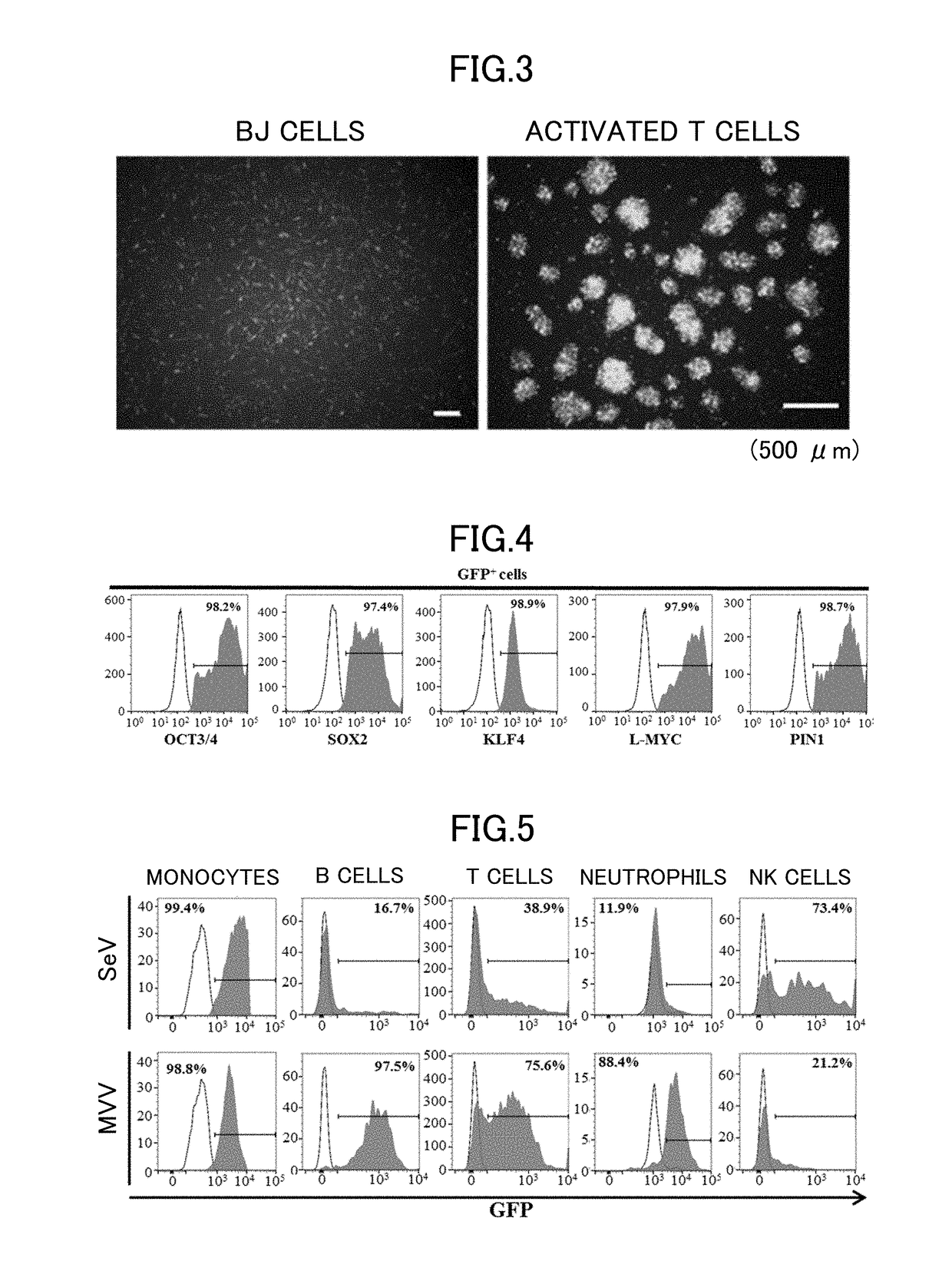Virus vector, cell, and construct
a virus vector and cell technology, applied in the field of virus vectors, cells and constructs, can solve the problems of limited cell types that can be used, lentivirus vectors and retrovirus vectors are problematic in genomic toxicity, adenovirus vectors and non-viral vectors are problematic in extremely low transduction efficiency, etc., to achieve efficient introduction into wide-ranging cells and high degree of safety
- Summary
- Abstract
- Description
- Claims
- Application Information
AI Technical Summary
Benefits of technology
Problems solved by technology
Method used
Image
Examples
embodiment 1
[0058]First, Embodiment 1 is explained in detail. A virus vector according to this embodiment contains a genome derived from a virus belonging to the family Paramyxoviridae.
[0059]The virus belonging to the family Paramyxoviridae (hereinafter, also simply referred to as “virus”) is an RNA virus having a (−) strand RNA genome. Examples of the virus include Measles virus, Sendai virus, Newcastle disease virus, Mumps virus, Parainfluenza virus 1, Parainfluenza virus 2, Parainfluenza virus 3, Parainfluenza virus 5 or Simian virus 5, Metapneumo virus, Respiratorysyncytial virus, Rinderpest virus, and Distemper virus. The virus belonging to the family Paramyxoviridae is preferably measles virus.
[0060]The genome of the virus belonging to the family Paramyxoviridae is unsegmented single-stranded RNA, having a leader sequence (Le) at the 3′ end and a trailer sequence (Tr) at the 5′ end. Various genes encoding functional proteins that constitute the virus are located between the leader sequenc...
embodiment 2
[0105]Next, Embodiment 2 is explained. Cells according to this embodiment are transduced with foreign genes by the virus vector according to the above Embodiment 1.
[0106]The virus vector can be caused to infect cells by a known method. For example, the virus vector is added to a culture solution containing cells, and then the solution may be centrifuged at room temperature at 1,200×g for 45 minutes. Further examples of a method for causing the virus vector to infect cells include electroporation, lipofection, a heat shock method, a PEG method, a calcium phosphate method and a DEAE dextran method, which involve causing various types of virus to infect cells.
[0107]Examples of cells are not particularly limited and include human somatic cells, fibroblasts, and blood cells, as well as monkey somatic cells. Preferred examples of cells include B cells, activated or inactivated T cells, granulocytes, and blood cells including hematopoietic stem cells. Examples of particularly preferred cel...
example 1
Construction of Non-Transmissible Gene-Modified Measles Virus Vector
[0118]Non-transmissible gene-modified measles virus vector was produced by co-culture of two plasmids (MV-HL-K-Pin1-EGFP and MV-NPM-OSM) containing genes encoding measles-virus-constituting functional proteins and four plasmids (pCITE-IC-N, pCITE-IC-PΔC, pCITEko-9301B-L, pCA7-IC-F) that help viral synthesis, with Vero / SLAM / F cells prepared as package cells by introducing a SLAM gene and the F gene of measles virus into BHK-T7 / 9 cells, as described below. As foreign genes, an OCT3 / 4 gene, an SOX2 gene, an L-MYC gene, a KLF4 gene and a PIN1 gene to be used for iPS cell preparation, and an EGFP gene as a reporter gene were inserted.
[0119]First, for insertion of N390I, N416D, N481Y, and E492G mutations into the H protein, and for insertion of P64S and E89K mutations into the M protein, wild-type H and M genes of a measles virus strain, MV-IC323-EGFP, were modified by genetic recombination.
[0120]Subsequently, as shown in...
PUM
| Property | Measurement | Unit |
|---|---|---|
| temperature | aaaaa | aaaaa |
| temperature | aaaaa | aaaaa |
| composition | aaaaa | aaaaa |
Abstract
Description
Claims
Application Information
 Login to View More
Login to View More - R&D
- Intellectual Property
- Life Sciences
- Materials
- Tech Scout
- Unparalleled Data Quality
- Higher Quality Content
- 60% Fewer Hallucinations
Browse by: Latest US Patents, China's latest patents, Technical Efficacy Thesaurus, Application Domain, Technology Topic, Popular Technical Reports.
© 2025 PatSnap. All rights reserved.Legal|Privacy policy|Modern Slavery Act Transparency Statement|Sitemap|About US| Contact US: help@patsnap.com



